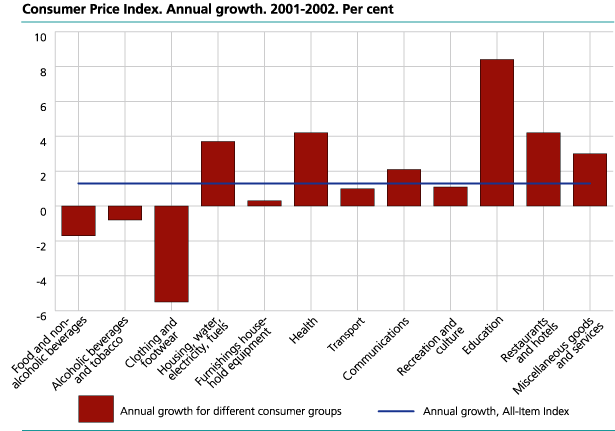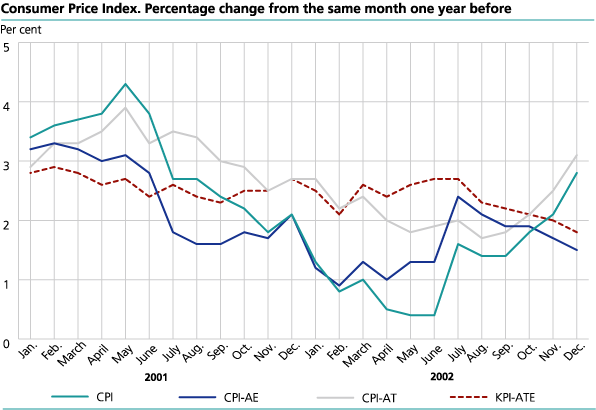Content
Published:
This is an archived release.
Low price growth in 2002
The Consumer Price Index (CPI) rose by 1.3 per cent from 2001 to 2002. The low price growth was mainly caused by tax reductions and lower prices of clothing. CPI adjusted for tax changes and excluding energy products (CPI-ATE) increased by 2.3 per cent in 2002.
From 15 November to 15 December 2002 the consumer prices increased by 0.8 per cent. The year-to-year growth in December (December 2001 - December 2002) was 2.8 per cent. The CPI stood at 111.9 (1998=100) in December 2002 in comparison with 108.9 in December 2001. CPI was on average 110.1 in 2002.
Annual growth 2002: Lower prices of clothing and tax reductions
The CPI rose by 1.3 per cent from 2001 to 2002, which is the lowest price increase since 1996. The price growth reached its lowest level in May and June 2002 as the year-to-year change came down to 0.4 per cent. Especially the prices of clothing contributed to dampen the annual price growth with a decrease of 6.2 per cent. With this price decrease the tendency since 1995 continues. In comparison to the clothing prices, the prices of footwear fell less by 1.7 per cent. The prices of clothing and footwear went down by 5.5 per cent all together. The prices of women clothing fell more than the prices of men and children clothing.
The petrol prices also contributed to the low price growth in 2002. The prices fell on average by 3.8 per cent. In January 2002 the prices increased by 3.4 per cent due to petrol taxes adjusted for inflation at the turn of the year and the subsidy on cargo was abolished. The prices then continued to increase and reached a peak in April with a 5.2 per cent increase. For the rest of the year the prices showed fluctuations, which can be seen in connection with the changes in the prices of petroleum.
The tariffs on electricity declined on average by 1.5 per cent in 2002 caused among other things by a reduction of the consumption tax on electricity of NOK 2 øre/kWh as of 1st of January 2002. Unlike the development in 2001, the tariffs on electricity showed a more regular seasonal pattern in the first half of 2002 with decreasing prices during the spring. From August the tariffs started to increase and in the last four months of 2002 the tariffs made huge jumps, much stronger than in the same periods in previous years. During the last six months the tariffs increased by 47.1 per cent. CPI excluding electricity was 1.3 per cent while the CPI excluding energy products (CPI-AE) was 1.6 per cent in 2002.
Airline fares fell by 3.1 per cent in 2002, mainly due to the removal of the passenger tax on flights as of 1st of April, and contributed along with the prices of energy products to moderate the rise in the consumer price growth.
Due to the reduction in the value added tax in July 2001, the prices of food and non-alcoholic beverages declined by 1.7 per cent in 2002. The prices of alcoholic beverages and tobacco also decreased. The prices of alcoholic beverages fell by 3.5 per cent mainly due to tax reductions at the turn of the year. The prices of tobacco, on the other hand, increased by 2.9 per cent in 2002.
The CPI adjusted for tax changes (CPI-AT) increased by 2.2 per cent. Lower taxes reduced the consumer price growth by 0.9 percentage points, which was a result of among other things the reduction in the value added tax on food in 2001, lower electricity and alcohol taxes and the removal of the passenger tax on flights in 2002. The CPI-ATE went up by 2.3 per cent in 2002.
Rentals were the main contributing factor to the price increase in 2002. The costs for owner-occupied housing and rentals for housing rose by 4.9 and 4.4 per cent respectively. The prices of services connected to maintenance and repair of dwelling increased by 4.4 per cent and contributed to a further increase in the housing expenses.
The prices for different services such as educational expenses, accommodation and restaurant services and different services connected to health care increased more than the average price growth in 2002. Also insurance premiums rose in 2002 by 6.2 per cent.
The consumer prices up 0.8 per cent from November to December
The tariffs on electricity continued to rise in December by 18.4 per cent. The price rise contributed with more than 0.6 percentage points to the total consumer price growth in December. The strong increase is caused by low amount of rainfall. The price rise is much stronger compared with the same period in previous years. Costs for owner-occupied housing and rentals for housing increased marginally by 0.3 and 0.2 per cent respectively.
The prices of food and non-alcoholic beverages rose slightly by 0.2 per cent from November to December. The prices of fresh vegetables increased while the prices of fruit decreased.
The prices of transport services increased marginally in December. A rise in taxi fees was registered, as well as a slight increase in the prices of passenger transport by air.
Year-to-year change: Higher tariffs on electricity
From December 2001 to December 2002 the consumer prices rose by 2.8 per cent. The development in the tariffs on electricity was the most important contributor to the year-to-year growth. During this period the tariffs on electricity increased by 27.8 per cent. Costs of owner-occupied housing and rentals for housing went up 3.5 and 3.6 per cent respectively from December 2001 to December 2002. Other factors such as the prices of petrol and food contributed to the CPI growth as well, with price increases of 7.8 and 3.1 per cent respectively. The CPI-AE went up by 1.5 per cent during the last 12 months. With that the prices of energy products increased the CPI by 1.3 percentage points. There were also among other things registered an increase in insurance and personal care expenditures and a price rise of restaurant services and services connected to health care.
The year-to-year change in the CPI went from 2.1 per cent in November to 2.8 per cent in December. The increase was mainly due to the development in the tariffs on electricity. The tariffs on electricity increased by 18.4 per cent from November to December 2002 compared with a decrease of 0.3 per cent during the same period in 2001. The price development of petrol contributed to the increase in the year-to-year change as well. The prices of petrol declined by 1.2 per cent from November to December 2001, while there was no change in the same period the year after. Costs for owner-occupied housing was the single most important contribution in the opposite direction. From November to December 2002 costs for owner-occupied housing rose by 0.3 per cent, compared with an increase of 1.1 per cent at the same time the year before.
CPI-ATE went from 2.0 per cent in November to 1.8 per cent in December. The year-to-year change in the CPI-AT was 3.1 per cent in December, up from 2.5 per cent in November. Tax reductions as a total decreased CPI by 0.3 percentage points.
The Price Index of Retail Trade, according to The Standard Industrial Classification, has been published with the CPI. Due to changes in methods of calculations Statistics Norway has decided not to publish the Retail Trade Price Index for the time being.
| The Consumer Price Index. 1998 = 100 |
| Index | Change in per cent | ||||||||||||||||||||||||||||||||||||||
|---|---|---|---|---|---|---|---|---|---|---|---|---|---|---|---|---|---|---|---|---|---|---|---|---|---|---|---|---|---|---|---|---|---|---|---|---|---|---|---|
| December 2002 | November 2002-December 2002 | December 2001- December 2002 | Annual growth 2001-2002 | ||||||||||||||||||||||||||||||||||||
| CPI All-item index | 111.9 | 0.8 | 2.8 | 1.3 | |||||||||||||||||||||||||||||||||||
| Food and non-alcoholic beverages | 101.7 | 0.2 | 3.0 | -1.7 | |||||||||||||||||||||||||||||||||||
| Alcoholic beverages and tobacco | 113.6 | 0.1 | -1.0 | -0.8 | |||||||||||||||||||||||||||||||||||
| Clothing and footwear | 89.2 | -0.3 | -7.0 | -5.5 | |||||||||||||||||||||||||||||||||||
| Housing, water, electricity, fuels | 126.2 | 3.2 | 7.7 | 3.7 | |||||||||||||||||||||||||||||||||||
| Furnishings household equipment | 103.0 | -0.1 | 0.3 | 0.3 | |||||||||||||||||||||||||||||||||||
| Health | 117.6 | 0.2 | 4.8 | 4.2 | |||||||||||||||||||||||||||||||||||
| Transport | 112.8 | 0.1 | 1.9 | 1.0 | |||||||||||||||||||||||||||||||||||
| Communications | 89.0 | - | 2.3 | 2.1 | |||||||||||||||||||||||||||||||||||
| Recreation and culture | 105.5 | -0.1 | 0.9 | 1.1 | |||||||||||||||||||||||||||||||||||
| Education | 131.5 | - | 4.9 | 8.4 | |||||||||||||||||||||||||||||||||||
| Restaurants and hotels | 117.7 | 0.3 | 3.9 | 4.2 | |||||||||||||||||||||||||||||||||||
| Miscellaneous goods and services | 115.9 | - | 2.7 | 3.0 | |||||||||||||||||||||||||||||||||||
| CPI-AE | 109.4 | 0.1 | 1.5 | 1.6 | |||||||||||||||||||||||||||||||||||
| CPI-AT | 0.8 | 3.1 | 2.2 | ||||||||||||||||||||||||||||||||||||
| CPI-ATE | 0.1 | 1.8 | 2.3 | ||||||||||||||||||||||||||||||||||||
Contact
-
Statistics Norway's Information Centre
E-mail: informasjon@ssb.no
tel.: (+47) 21 09 46 42
-
Konsumprisindeksen
E-mail: konsumprisindeksen@ssb.no
tel.: (+47) 62 88 56 34
-
Camilla Rochlenge
E-mail: camilla.rochlenge@ssb.no
tel.: (+47) 40 90 23 72
-
Kjersti Nyborg Hov
E-mail: kjersti.nyborg.hov@ssb.no
tel.: (+47) 40 90 23 63
-
Gunnar Larsson
E-mail: gunnar.larsson@ssb.no
tel.: (+47) 40 90 26 79
-
Trym Kristian Økland
E-mail: trym.okland@ssb.no
tel.: (+47) 46 81 09 15


